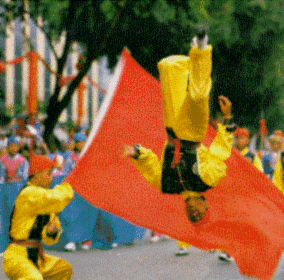

 Before
Raffles came to Singapore, the Chinese, Arabs and Indians have already
moved to Singapore. After Raffles came, people of all races quickly made
their way to Singapore. By 1911, Singapore had 250 000 people of 48 races,
speaking 54 languages altogether.
Before
Raffles came to Singapore, the Chinese, Arabs and Indians have already
moved to Singapore. After Raffles came, people of all races quickly made
their way to Singapore. By 1911, Singapore had 250 000 people of 48 races,
speaking 54 languages altogether.
Today, Singapore is a fine example of how people from different races are able to live and work in harmony; their fascinating festivals, food and religions have made Singapore a rich blend of races, attracting some six million tourists to Singapore yearly.
 The Chinese,
who form about three-quarters (76%) of Singaporeans, have brought along
their cultural festivals, food and strong family ties. You may experience
the Chinese culture in Chinatown, where there are traditional shophouses
and temples, and craftsmen at work. Chinatown is filled with activity especially
during Chinese New Year.
The Chinese,
who form about three-quarters (76%) of Singaporeans, have brought along
their cultural festivals, food and strong family ties. You may experience
the Chinese culture in Chinatown, where there are traditional shophouses
and temples, and craftsmen at work. Chinatown is filled with activity especially
during Chinese New Year.
 The
Malays, who are about one-seventh (15%) of the population, have qualities
such as their strong sense of community, their spicy cooking and their
Islamic religious values. Arab Street provides a peek into the Muslim way
of life. There, you will find the impressive Sultan Mosque, colourful silks
and fabrics, jewellery, perfumes and many others.
The
Malays, who are about one-seventh (15%) of the population, have qualities
such as their strong sense of community, their spicy cooking and their
Islamic religious values. Arab Street provides a peek into the Muslim way
of life. There, you will find the impressive Sultan Mosque, colourful silks
and fabrics, jewellery, perfumes and many others.
 The Indians, comprising
one-fifteenth (6.5%) of the population, are famous for their strong sense
of family, remarkable curries and striking religious festivals. Little
India is a fine place to learn about the Indian community. Small shops
selling silks, garlands,
jewellery and spices may be found in Little India, along with two temples
- the Sri Veerama Kaliaman and Sri Srinivasa Perumal Temples.
The Indians, comprising
one-fifteenth (6.5%) of the population, are famous for their strong sense
of family, remarkable curries and striking religious festivals. Little
India is a fine place to learn about the Indian community. Small shops
selling silks, garlands,
jewellery and spices may be found in Little India, along with two temples
- the Sri Veerama Kaliaman and Sri Srinivasa Perumal Temples.
Eurasians, Arabs, Armenians, Jews, Europeans and Peranakans are also part of the Singapore mixture of cultures. Although our racial backgrounds are different, we share common qualities - a love of family, a liking for hard work, and a pride in our roots.

The whole range of colourful festivals in Singapore is what we share as Singaporeans, and they are perfect for us to learn more about other cultures.
The Chinese New Year is one major festival among the Chinese community. It represents a fresh start of the year. Preparations for the New Year start weeks before the festival, and these include spring-cleaning and buying New Year goods.
 On New Year's
Eve, all members of the family try their best to make it for the reunion
dinner, which shows the importance of close family ties to Chinese. On
New Year's Day, the young offer New Year greetings along with Mandarin
oranges to elders, while red packets are given in return to the young,
to wish them good fortune in the new year. The Chingay Procession, held
near Chinese New Year, is a national event which local and even overseas
performing groups participate in.
On New Year's
Eve, all members of the family try their best to make it for the reunion
dinner, which shows the importance of close family ties to Chinese. On
New Year's Day, the young offer New Year greetings along with Mandarin
oranges to elders, while red packets are given in return to the young,
to wish them good fortune in the new year. The Chingay Procession, held
near Chinese New Year, is a national event which local and even overseas
performing groups participate in.
The Muslims in Singapore celebrate two main festival, Hari Raya Puasa and Hari Raya Haji. Hari Raya Puasa is celebrated at the end of the Muslim month of fasting. Muslims usually attend prayers in the mosque in the morning, and then have a feast of thanksgiving with their families and friends.
Hari Raya Haji is celebrated a day after those who go on the religious journey gather in the Islamic Holy Land of Mecca. A goat or buffalo is offered to Allah (God) during this occasion.
 The Tamil Hindus
celebrate Thaipusam during the Tamil month of Thai (between January and
February). Devotees carry kavadis
in penitence
or thanksgiving.
The Tamil Hindus
celebrate Thaipusam during the Tamil month of Thai (between January and
February). Devotees carry kavadis
in penitence
or thanksgiving.
Deepavali is celebrated by the Hindus and Sikhs in the Tamil month of
Aipasi. There are many legends behind Deepavali, and one of them says it
marks the killing of a wicked ruler by Lord Krishna. This represents the
victory of good over evil, and light over darkness. That is why Deepavali
is also known as the Festival of Lights. For children, Deepavali is a happy
time because they receive sweet treats and go on visits.
Copyright © 1999
'Unique Singapore' was designed for the NE Website Design Competition organised by the MOE

When you see words
in blue, you may move
your mouse over them
to see their meanings.
You do not have to
click your mouse.